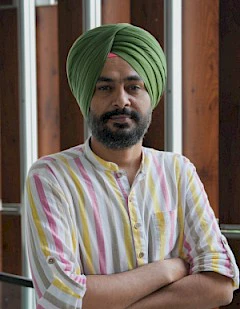Mathematical and Physical Sciences

Raghwinder Singh Grewal
Assistant Professor
PhD (Indian Institute of Technology Madras)
+91.79.61911533
Research Interests: Atomic Magnetometry, Quantum Sensing, Nonlinear-Optics
Profile
Professor Raghwinder Singh Grewal is an Assistant Professor in the Mathematical and Physical Sciences division of the School of Arts and Sciences at Ahmedabad University. He received his MSc and PhD from the Department of Physics, Indian Institute of Technology (IIT) Madras. During his PhD, he investigated the Hanle resonances in degenerate two-level atomic systems. He was awarded a pre-doctoral fellowship by IIT Madras for submitting his PhD thesis within four years. Upon completion of the doctorate, he joined Jagiellonian University, Krakow (Poland) as a post-doctoral fellow where he worked on the transient dynamics of nonlinear magneto-optical rotation (NMOR) and its dependence on the transverse magnetic fields. In his second post-doctoral stint at the Physical Research Laboratory, Ahmedabad, his work was focused on simultaneous generation of one- and two-dimensional Airy beams and studying their second harmonic characteristics. He received international travel support (ITS) from SERB-DST during his time at the Physical Research Laboratory.
Prior to joining Ahmedabad University, Professor Grewal worked at Delaware State University, Dover, USA as a post-doctoral research associate, where he developed a new technique to generate magnetic resonances with synchronous modulation of two laser fields, which would be useful for remote sensing of geomagnetic fields using mesospheric sodium atoms.
Research
Professor Singh leads the Light-Matter Interaction Laboratory at Ahmedabad University, which focuses on cutting-edge research in atomic and optical physics, with a particular emphasis on quantum sensing of magnetic fields using warm alkali vapors. His research group is actively engaged in developing optically pumped atomic magnetometers using various techniques, such as nonlinear magneto-optical rotation (NMOR), coherent population trapping (CPT), free-induction decay (FID) of atoms, and the Bell-Bloom method. The primary focus of his current research is to address key challenges related to atomic magnetometers, such as the dead-zone problem, heading error, operation in an unshielded magnetic environment, etc. His team is working to push the sensitivity of these magnetometers closer to the fundamental quantum limits while also maximizing bandwidth for detecting fast-changing magnetic signals. These atomic magnetometers have a wide range of real-world applications, including biomedical imaging, geophysical exploration, space research, magnetic navigation, and precision measurements in fundamental physics.
Publications
- Sudip Mandal, Raghwinder Singh Grewal, and Swarupananda Pradhan, Enhanced optical pumping using mutually orthogonal magnetic fields for quantum sensing, EPL, 147, 35003 (2024).
- Pooja Kumari, Shrey Mehta, Raghwinder Singh Grewal, and R. P. Singh, Double Hanle resonance dependence on light polarization angle and transverse magnetic field direction, J. Opt 26, 075403 (2024).
- Raghwinder Singh Grewal, Effect of light ellipticity and polarization angle on the transient dynamics of a ground state Hanle effect, J. Opt 25, 125404 (2023).
- Gour S. Pati, Renu Tripathi, Raghwinder Singh Grewal, Mauricio Pulido, and Robin A. Depto, Synchronous coherent population trapping and its magnetic spectral response in rubidium vapor, Phys. Rev. A 104, 033116 (2021).
- Raghwinder Singh Grewal, Mauricio Pulido, Gour Pati, Renu Tripathi, Magnetometry using sodium fluorescence with synchronous modulation of two resonant light fields, Appl. Phys. Lett. 117, 214002, (2020).
- Raghwinder Singh Grewal, Gour Pati, Renu Tripathi, Light ellipticity and polarization angle dependence of magnetic resonances in rubidium vapor using amplitude-modulated light: Theoretical and experimental investigations, Phys. Rev. A 102, 033102, (2020).
- Raghwinder Singh Grewal and Szymon Pustelny, Transient dynamics of nonlinear magneto-optical rotation in the presence of transverse magnetic field, Phys. Rev. A 101, 033825, (2020).
- Raghwinder Singh Grewal, Gour Pati, Renu Tripathi, Anthony W. Yu, Michae Krainak and Michael Purucker, Magneto-optical resonances in fluorescence from sodium D2 manifold, Optics Express 28, 1114, (2020).
- Raghwinder Singh Grewal, Anirban Ghosh and Goutam K. Samanta, Simultaneous generation of high-power, ultrafast 1D and 2D Airy beams and their frequency-doubling characteristics, Optics Letters 43, 3957 (2018).
- Raghwinder Singh Grewal, Szymon Pustelny, A. Rybak, and M. Florkowski, Transient dynamics of nonlinear magneto-optical rotation, Phys. Rev. A. 97, 043832 (2018).
- Raghwinder Singh Grewal and M. Pattabiraman, Magnetic field measurements in Rb vapor by splitting Hanle resonances under the presence of a perpendicular scanning magnetic field, Eur. Phys. J. D 70, 219, (2016).
- Raghwinder Singh Grewal and M. Pattabiraman, Hanle electromagnetically induced absorption in open Fg -> Fe(< Fg) transitions of 87Rb D2 line, J. Phys. B: At. Mol. Opt. Phys. 48, 085501, (2015).
- Raghwinder Singh Grewal and M. Pattabiraman, Effect of an additional magnetic field on Hanle-type absorption resonances, J. Phys. B: At. Mol. Opt. Phys. 47, 19550, (2014).
Teaching
- PHY122 Laboratory Physics – Electromagnetism
- PHY112 Electromagnetic Theory
- PHY 221 Laboratory Physics – Optics
- PHY 315 Atomic and Nuclear Physics
- PHY 733 Laser Matter Interaction
- PHY734 Nonlinear Optics
- PHY 736 Quantum Optics
